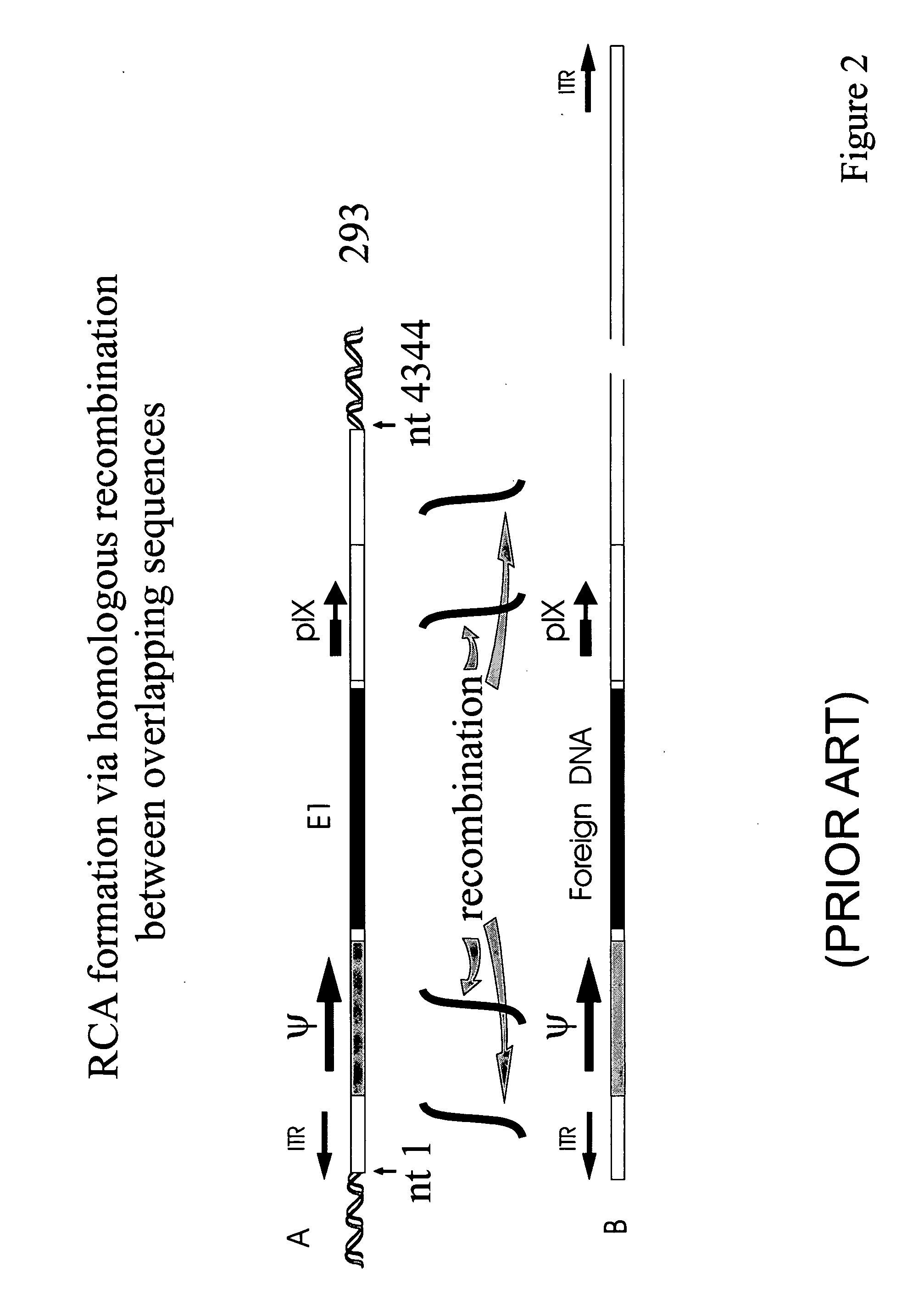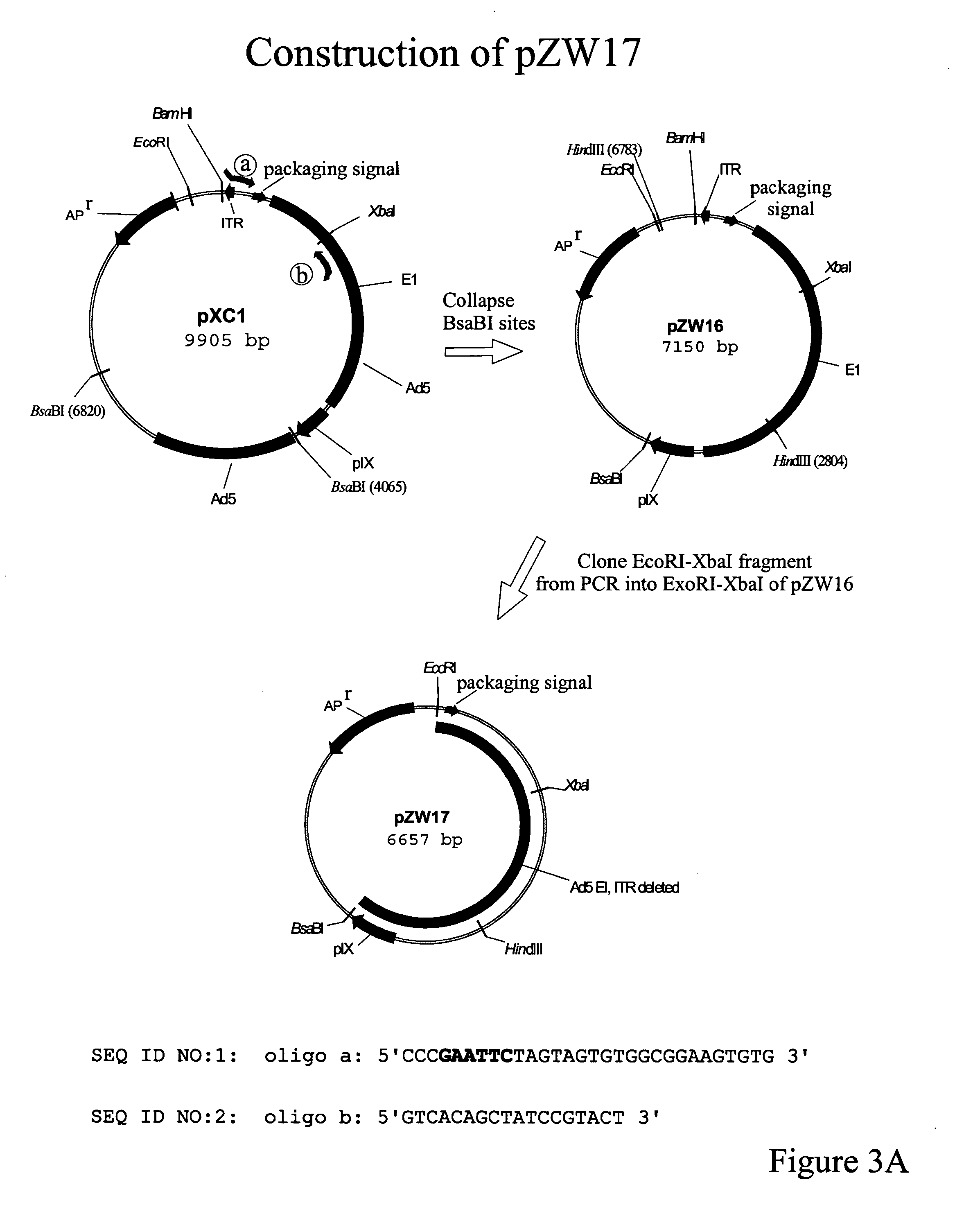Production of adenovirus vectors with reduced levels of replication competent adenovirus contamination
a technology of adenovirus and adenovirus, which is applied in the direction of biocide, plant growth regulator, sugar derivative, etc., can solve the problems of replication competent adenoviruses, significant problem of rca in vector stocks, and removal of pix gene cannot be expected to prevent absolutely the occurrence of rca
- Summary
- Abstract
- Description
- Claims
- Application Information
AI Technical Summary
Problems solved by technology
Method used
Image
Examples
example 1
[0121] In order to better appreciate and understand the reasoning that led to the identification of the problem and to the conception and reduction to practice of the present invention, it is useful to describe earlier laboratory efforts to reduce the levels of contaminating RCA in FG Recombinant adenoviral vector preparations. First, it is noted that it is theoretically possible to rescue a functional E1+virus following a single recombination event between vector and 293 cell DNA sequences rightward of E1 followed by a repair process involving annealing of left viral ITR integrated in the 293 cell genome and the right ITR of the vector by a process elucidated by Lippe and Graham (Lippe, R. and Graham, F. L. Adenoviruses with non-identical terminal sequences are viable. J. Virol. 63: 5133-5141, 1989). However, Hehir et al. showed that RCA formation appears to result from two recombination events on either side of the E1 region (Hehir, K. M., Armentano, D., Cardoza, L. M., Choquette,...
example 2
[0123] Considering the data from Example 1, and considering the two-recombination-events hypothesis of RCA formation, further consideration of panel B of FIG. 3B lead to conception of a possible solution to the problem of RCA formation in virus preparations grown in HER224 cells. If the packaging signal (and adjacent adenoviral nucleotides up to the inserted foreign DNA in E1) in the Recombinant adenoviral vector genome were moved to the right end of the genome, where it is known that it can function as a packaging signal in such position, then there would be no left end homologous sequence recombinable with the DNA of adenoviral sequences introduced into the HER224 cells to provide E1 functions, and recombination as illustrated in panel B should be impossible. Therefore, a series of plasmids were constructed as shown in FIGS. 4A to 4F, which culminated in shuttle plasmids that could be combined with an Ad genomic plasmid, pBHGfit(del)E1,3FLP, via the action of the site specific rec...
example 3
[0125] During study of various models of recombination to explain the production of RCA in AdFG190LacZ vector preparations grown in HER224 cells, the inventor arrived at a primary conception of the present invention. For close examination of panel D of FIG. 5 reveals that if the packaging signal at the right end of the vector genome had been inverted with respect to its normal orientation (relative to the adjacent, right ITR), the recombination event illustrated in FIG. 5D could not occur and the intermediate shown in FIG. 5C would not be packageable.
[0126]FIG. 7A thus illustrates a possible solution to the problem of RCA formation based on the above conception and reasoning. Inversion of the packaging signal relative to its normal orientation with respect to the viral DNA terminus (ITR) in the vectors constructed in the experiments described in FIG. 4 would block the second recombination event needed to produce viable RCA in vector preparations grown in HER224 cells as shown in FI...
PUM
| Property | Measurement | Unit |
|---|---|---|
| Nucleic acid sequence | aaaaa | aaaaa |
Abstract
Description
Claims
Application Information
 Login to View More
Login to View More - R&D
- Intellectual Property
- Life Sciences
- Materials
- Tech Scout
- Unparalleled Data Quality
- Higher Quality Content
- 60% Fewer Hallucinations
Browse by: Latest US Patents, China's latest patents, Technical Efficacy Thesaurus, Application Domain, Technology Topic, Popular Technical Reports.
© 2025 PatSnap. All rights reserved.Legal|Privacy policy|Modern Slavery Act Transparency Statement|Sitemap|About US| Contact US: help@patsnap.com



